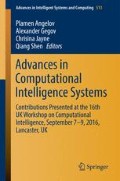Abstract
The detection of protein complexes is an important research problem in bioinformatics, which may help increase our understanding of the biological functions of proteins inside our body. Moreover, new discoveries obtained from identification of protein complexes may be considered important for therapeutic purposes. Several proteins linked with Alzheimer’s disease were investigated. By observing the connectivity between proteins using computational methods such as graph theory and clustering, we can uncover previously unknown relationships that are useful for potential knowledge discovery. Furthermore, we demonstrate how Markov Clustering (MCL) and the Molecular Complex Detection (MCODE) algorithm identify interesting patterns from the protein-protein interaction data related to Alzheimer’s disease.
Access this chapter
Tax calculation will be finalised at checkout
Purchases are for personal use only
References
Aittokallio, T.: Graph-based methods for analysing networks in cell biology. Briefings Bioinform. 7(3), 243–255 (2006)
Alberts, B.: The cell as a collection of protein machines: preparing the next generation of molecular biologists. Cell 92(3), 291–294 (1998)
Bader, G.D., Hogue, C.W.: An automated method for finding molecular complexes in large protein interaction networks. BMC Bioinform. 4(1), 2 (2003)
Barabási, A.-L., Oltvai, Z.N.: Network biology: understanding the cell’s functional organization. Nat. Rev. Genet. 5(2), 101–113 (2004)
Boyle, E.I., Weng, S., Gollub, J., Jin, H., Botstein, D., Cherry, J.M., Sherlock, G.: GO::TermFinder–open source software for accessing Gene Ontology information and finding significantly enriched Gene Ontology terms associated with a list of genes. Bioinformatics (Oxford, England), 20(18):3710–3715 (2004)
Brohee, S., Van Helden, J.: Evaluation of clustering algorithms for protein-protein interaction networks. BMC Bioinform. 7(1), 488 (2006)
Chatr-aryamontri, A., Ceol, A., Palazzi, L.M., Nardelli, G., Schneider, M.V., Castagnoli, L., Cesareni, G.: MINT: the Molecular INTeraction database. Nucleic Acids Res. 35 (Database issue), D572–574 (2007)
Enright, A.J., Van Dongen, S., Ouzounis, C.A.: An efficient algorithm for large-scale detection of protein families. Nucleic Acids Res. 30(7), 1575–1584 (2002)
Feng, J., Jiang, R., Jiang, T.: A max-flow-based approach to the identification of protein complexes using protein interaction and microarray data. IEEE/ACM Trans. Comput. Biol. Bioinform. 8(3), 621–634 (2011)
Handl, J.Knowles, Kell, D.B.: Computational cluster validation in post-genomic data analysis. Bioinformatics 21(15), 3201–3212 (2005)
King, A.D., Przulj, N., Jurisica, I.: Protein complex prediction via cost-based clustering. Bioinformatics 20(17), 3013–3020 (2004)
Klapa, M.I., Tsafou, K., Theodoridis, E., Tsakalidis, A., Moschonas, N.K.: Reconstruction of the experimentally supported human protein interactome: what can we learn? BMC Syst. Biol. 7(1), 96 (2013)
Kolaczyk, E.D., Csárdi, G.: Statistical Analysis of Network Data with R. Springer, New York (2014)
Kumar, M., Agrawal, K.K., Arora, D.D., Mishra, R.: Implementation and behavioural analysis of graph clustering using restricted neighborhood search algorithm. Int. J. Comput. Appl. 22(5), 15–20 (2011)
Li, X.-L., Ng, S.-K. (eds.): Biological Data Mining in Protein Interaction (2009)
Li, X., Wu, M., Kwoh, C.-K., Ng, S.-K.: Computational approaches for detecting protein complexes from protein interaction networks: a survey. BMC Genom. 11(Suppl 1), S3 (2010)
McGarry, K., Slater, N., Ammaning, A.: Identifying candidate drugs for repositioning by graph based modeling techniques based on drug side-effects. In: The 15th UK Workshop on Computational Intelligence, UKCI-2015, pp. 1–8 (2015)
Samatova, N.F., Hendrix, W., Jenkins, J., Padmanabhan, K., Chakraborty, A.: Practical Graph Mining with R. CRC Press (2013)
Sheinerman, F.B., Norel, R., Honig, B.: Electrostatic aspects of protein–protein interactions. Curr. Opin. Struct. Biol. 10(2), 153–159 (2000)
Spirin, V., Mirny, L.A.: Protein complexes and functional modules in molecular networks. Proc. Natl. Acad. Sci. 100(21), 12123–12128 (2003)
Sprinzak, E., Sattath, S., Margalit, H.: How reliable are experimental protein-protein interaction data? J. Mol. Biol. 327(5), 919–923 (2003)
Szklarczyk, D., Franceschini, A., Wyder, S., Forslund, K., Heller, D., Huerta-Cepas, J., Simonovic, M., Roth, A., Santos, A., Tsafou, K.P., Kuhn, M., Bork, P., Jensen, L.J., von Mering, C.: STRING v10: protein-protein interaction networks, integrated over the tree of life. Nucleic Acids Res. 43(D1), D447–D452 (2015)
Watts, D., Strogatz, S.: Collective dynamics of “small-world” networks. Nature 393, 440–442 (1998)
Wu, M., Li, X.L., Kwoh, C.-K.: Algorithms for detecting protein complexes in PPI networks: an evaluation study. In: Proceedings of Third IAPR International Conference on Pattern Recognition in Bioinformatics (PRIB 2008). pp. 15–17 (2008)
Zhang, X.-F., Dai, D.-Q., Ou-Yang, L., Yan, H.: Detecting overlapping protein complexes based on a generative model with functional and topological properties. BMC Bioinform. 15(1), 186 (2014)
Author information
Authors and Affiliations
Corresponding author
Editor information
Editors and Affiliations
Rights and permissions
Copyright information
© 2017 Springer International Publishing AG
About this paper
Cite this paper
Rujirapipat, S., McGarry, K., Nelson, D. (2017). Bioinformatic Analysis Using Complex Networks and Clustering Proteins Linked with Alzheimer’s Disease. In: Angelov, P., Gegov, A., Jayne, C., Shen, Q. (eds) Advances in Computational Intelligence Systems. Advances in Intelligent Systems and Computing, vol 513. Springer, Cham. https://doi.org/10.1007/978-3-319-46562-3_14
Download citation
DOI: https://doi.org/10.1007/978-3-319-46562-3_14
Published:
Publisher Name: Springer, Cham
Print ISBN: 978-3-319-46561-6
Online ISBN: 978-3-319-46562-3
eBook Packages: EngineeringEngineering (R0)

